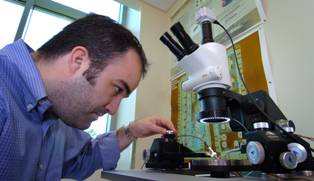|
|
|
| Neurology | |
Miniature device implanted in brain could monitor and treat epilepsy15 August 2007 Purdue University researchers have developed a new miniature device designed to be implanted in the brain to predict and prevent epileptic seizures. They have developed a tiny transmitter three times the width of a human hair to be implanted below the scalp to detect the signs of an epileptic seizure before it occurs. The system will record neural signals relayed by electrodes in various points in the brain.
"When epileptics have a seizure, a particular part of the brain starts firing in a way that is abnormal," said Pedro Irazoqui, an assistant professor of biomedical engineering. "Being able to record signals from several parts of the brain at the same time enables you to predict when a seizure is about to start, and then you can take steps to prevent it." Data from the implanted transmitter will be picked up by an external receiver, also being developed by the Purdue researchers. The transmitter consumes 8.8 milliwatts, about one-third as much power as other implantable transmitters while transmitting 10 times more data, and can collect data related to epileptic seizures from 1,000 channels, or locations in the brain. The electrodes that pick up data will be inserted directly in the brain through holes in the skull and then connected to the transmitter by wires. A commercial implantable device that can record epilepsy data from eight channels has been developed by other researchers is currently in clinical trials at several sites, including the Indiana University School of Medicine. The research has been funded by Chicago-based Citizens United for Research in Epilepsy (CURE). Irazoqui's research group also recently received a two-year grant from the Wallace H. Coulter Foundation to further develop the technology. "We are planning on doing human testing in two years," Irazoqui said. "Epilepsy affects about 1% of the global population, and of that 1%, 30% don't respond to any drugs. There is no cure or treatment for those 30%." New technologies being developed aim to change that by predicting the onset of seizures and immediately dispensing a chemical called a neurotransmitter directly to the area of the brain where the seizure is starting. The research represents half of a larger collaboration at Purdue focusing on creating a neuroprosthesis that dispenses a neurotransmitter chemical called GABA and calms the brain once the onset of a seizure is detected. This work is a collaboration between Irazoqui and Jenna Rickus, an assistant professor of biomedical engineering. Rickus has developed a 'living electrode' coated with specially engineered neurons that, when stimulated, releases the neurotransmitter to inhibit the seizure. The engineered neurons are living tissue stimulated with a microchip. Rickus and Irazoqui have shown that a certain amount of electrical current causes the neurons to release specific and controllable quantities of neurotransmitter. "The idea is that by using an engineered cell to release a neurotransmitter, we have a drug pump, in essence, that automatically refills itself and that only impacts the part of the brain where the living electrode is implanted: the epileptic focus," Irazoqui said. "So you are not going to get the side effects that you get by washing the entire body in a particular pharmaceutical." Papers on the project will be presented at the Engineering in Medicine and Biology Society's Sciences and Technologies for Health conference from Aug. 23-26 in Lyon, France.
|
